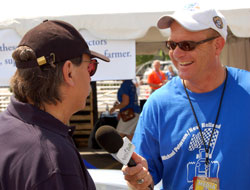The U.S. Senate is considering a bill this week that would continue to promote investment in traditional ethanol production while also pushing investments in research, technology and infrastructure for cellulosic ethanol production.
This article on Grainnet.com says the bill has the backing of the Renewable Fuels Association:
 “Record-high gas prices, continued unrest in oil-producing regions of the world and the fragility of America’s oil refining complex underscore the necessity of developing renewable alternatives to fossil fuel,” said Renewable Fuels Association President Bob Dinneen.
“Record-high gas prices, continued unrest in oil-producing regions of the world and the fragility of America’s oil refining complex underscore the necessity of developing renewable alternatives to fossil fuel,” said Renewable Fuels Association President Bob Dinneen.
“This bipartisan bill strikes an appropriate balance to continue the momentum spurred by the 2005 energy bill while providing the necessary incentives to bring next generation ethanol technology to the commercial market.”
Dinneen continued, “This bill is to cellulosic ethanol what the 2005 energy bill was to grain ethanol.
The legislation would have a new renewable fuels standard of 36 billion gallons of renewable fuel each year by 2022, loan guarantees for alternative fuel refineries to include cellulosic ethanol, grants for to build renewable fuel corridors, a study looking at the feasibility of building an ethanol pipeline, and a study on the impacts of using higher than 10 percent ethanol blends.


 In fact, NCGA President Ken McCauley tells
In fact, NCGA President Ken McCauley tells  NearBio, the innovator of technology that sends to your computer, cell phone, or mobile device info on where the nearest alternative fuel station is, has established a new web site:
NearBio, the innovator of technology that sends to your computer, cell phone, or mobile device info on where the nearest alternative fuel station is, has established a new web site: 
 According to
According to  “We are pleased to see that the Udall Foundation and the federal agencies and equipment manufacturers who are sponsoring the tour recognize biodiesel’s valuable contribution to the environment,” said NBB Chief Executive Officer Joe Jobe. “It is only fitting that the bus tour will feature many National Parks since the Park Service’s fleets were among the first in the nation to use biodiesel. Today, hundreds of fleets, including government, commercial and school buses, use biodiesel to benefit America’s environment, energy security and economy.”
“We are pleased to see that the Udall Foundation and the federal agencies and equipment manufacturers who are sponsoring the tour recognize biodiesel’s valuable contribution to the environment,” said NBB Chief Executive Officer Joe Jobe. “It is only fitting that the bus tour will feature many National Parks since the Park Service’s fleets were among the first in the nation to use biodiesel. Today, hundreds of fleets, including government, commercial and school buses, use biodiesel to benefit America’s environment, energy security and economy.”
 “Making these funds available represents this Administration’s ongoing commitment to promoting clean energy technologies to help diversify our nation’s energy mix in an environmentally sensitive way,” Energy Secretary Samuel Bodman said. “I am hopeful that these projects will play a critical role in furthering our knowledge of how we can cost effectively produce more homegrown, bio-based products to help reduce our reliance on imported sources of energy.”
“Making these funds available represents this Administration’s ongoing commitment to promoting clean energy technologies to help diversify our nation’s energy mix in an environmentally sensitive way,” Energy Secretary Samuel Bodman said. “I am hopeful that these projects will play a critical role in furthering our knowledge of how we can cost effectively produce more homegrown, bio-based products to help reduce our reliance on imported sources of energy.” Congress’ financial watchdog, the Government Accountability Office, says the U.S. Department of Energy lacks a plan for how to match up increased biofuels production with infrastructure and vehicles to use the green fuels.
Congress’ financial watchdog, the Government Accountability Office, says the U.S. Department of Energy lacks a plan for how to match up increased biofuels production with infrastructure and vehicles to use the green fuels. I-CARES will foster institutional, regional and international research on the development and production of biofuels from plant and microbial systems and the exploration of sustainable alternative energy and environmental systems and practices. Funding for the project will include a $55 million investment from Washington University.
I-CARES will foster institutional, regional and international research on the development and production of biofuels from plant and microbial systems and the exploration of sustainable alternative energy and environmental systems and practices. Funding for the project will include a $55 million investment from Washington University. While I was attending last week’s
While I was attending last week’s